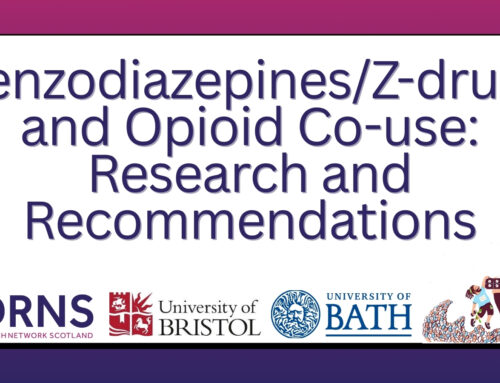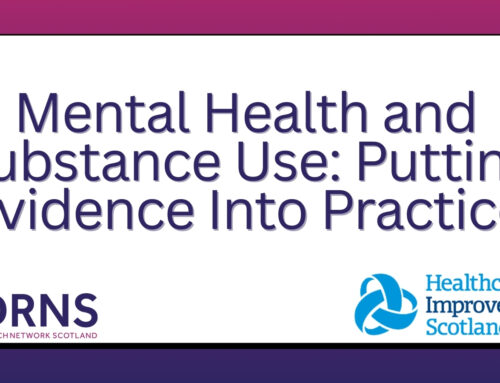The Prescription Opioid Overdose Risk 1 (POOR1) study: Developing a bespoke overdose prevention intervention for people who are prescribed high-strength opioids for chronic non-cancer pain

Introduction
This is the first of a two-part series that discusses recent research conducted by the Salvation Army Centre for Addiction Services and Research (SACASR) at the University of Stirling around prescription opioid overdose risk, in collaboration with NHS Fife.
What was the Prescription Opioid Overdose Risk 1 (POOR 1) study?
The study aimed to understand prescription opioid overdose knowledge and perceptions of overdose risk amongst people prescribed opioids for chronic non-cancer pain and non-related family members. In addition to this, the team developed a bespoke intervention to improve safety for people who use prescription opioids for chronic non-cancer pain. Key stakeholders, including people prescribed opioids for chronic non-cancer pain, non-related family members, and community pharmacists, appraised the intervention and provided important feedback about the perceived strengths and weaknesses of the intervention. Findings enabled the research team to refine the intervention and consider how to respond to potential implementation challenges.
Why did we do this research?
Evidence has proposed that there is a gap between perceptions of risk and the actual risk of overdose-related to prescription opioids. The consensus from previous research is that people who are prescribed high strength opioids for chronic non-cancer pain generally have low-risk perceptions related to their medication, and low knowledge related to prescription opioid overdose. Low perception of risk and low knowledge about what opioid overdoses might look like and how best to intervene can leave people vulnerable in the event of an overdose. The aim of this study was therefore to develop a bespoke overdose prevention intervention that attended to these gaps and improved the safety of people prescribed opioids. The intervention included overdose awareness education, the provision of take-home naloxone (an opioid antagonist that temporarily reverses the effects of an overdose), and naloxone training.
Why is the focus on prescription opioids?
Despite opioids having limited effects on improving functioning and reducing pain for people with chronic non-cancer pain, there have been increases in the prescribing of high-strength opioids to this group. Although there is considerable risk associated with taking prescription opioids long-term, this group are underserved, and they are not usually reached by other harm reduction interventions or services.
The study analysed GP practice data to characterise patients at opioid overdose risk in Fife. At the time, 42,382 patients were prescribed any opioid in the preceding 6 months and, of these, 14,079 (33%) were prescribed a strong opioid (>50mg morphine equivalent). There were considerable levels of comorbidities and polypharmacy that could increase risk of overdose among this group.
What were the findings?
All participant groups had positive attitudes toward the proposed intervention. However, aligned with previous evidence, perceptions of opioid overdose risk were very low amongst people prescribed opioids and family members. Perceived advantages of the intervention included the involvement of family members in the intervention, the proposed use of intranasal (as opposed to intramuscular) naloxone, and the peace of mind that came from having naloxone in the house. Perceived barriers were often related to people prescribed opioids not viewing themselves as being at risk. For example, people prescribed opioids and family members considered naloxone intervention in the future as being highly unlikely. Other perceived barriers included community pharmacies being under considerable time and resource pressure which was perceived to potentially impact the delivery of the intervention.
Findings from the POOR 1 study provided insight into overdose knowledge, opioid overdose risk, and perceptions of a bespoke take-home naloxone intervention from key stakeholder groups. Perceived strengths and weaknesses of the proposed intervention were identified by participants which informed a revised intervention package.
Next steps
Papers published from the study include Schofield et al. (2021) and Parkes et al. (2022), and a further paper on the study’s intervention development process is currently under review. Following findings from the POOR 1 study, the POOR 2 study piloted the bespoke intervention for people prescribed opioids for chronic non-cancer pain in NHS Grampian, to assess the feasibility and acceptability of the intervention in practice. This research will be discussed in the next blog post.
We are grateful to all participants, our collaborators at NHS Fife, the Expert by Experience group, and the Research Advisory Group, for being involved in the research and supporting the study throughout.
The study was led by Professor Tessa Parkes at the University of Stirling and co-investigators were: Mrs Deborah Steven (NHS Fife); Professor Catriona Matheson (University of Stirling); Professor Alexander Baldacchino (University of St Andrews and NHS Fife); Dr Andrew McAuley (Glasgow Caledonian University). Dr Rebecca Foster was the study’s Research Fellow.






